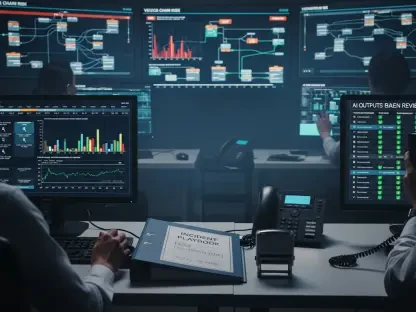Simon Glairy is a distinguished expert in the fields of insurance and Insurtech, notably specializing in risk management and AI-driven risk assessments. With a deep understanding of the challenges facing modern businesses, Simon provides insights on how interconnected trends are reshaping the landscape. In this interview, we explore themes from Aon’s Client Trends 2025 report, offering a glimpse into the dynamics transforming business operations and societal systems.
How are the four megatrends Aon identifies impacting businesses and societal systems?
Aon outlines trade, technology, climate, and workforce dynamics as the influential megatrends reshaping both business operations and societal systems. These forces are evolving simultaneously and their complex interdependencies make it difficult for organizations to navigate. Each trend not only has individual impacts but collectively presents opportunities and risks that are altering the way businesses function and respond to emerging challenges.
Can you describe the interconnectedness of these megatrends and why they can lead to decision paralysis among business leaders?
The intertwining of these megatrends makes them particularly challenging for business leaders. Trade impacts are magnified by technological advancements, which in turn affect workforce dynamics, while climate changes influence all of these elements. This connectivity can lead to decision paralysis because leaders require access to integrated data and expertise to make informed choices rapidly and effectively; lacking these resources can stall necessary actions in a fast-moving environment.
How does the intersection of trade and technology present new opportunities and challenges for businesses?
This intersection offers immense opportunities for efficiency and innovation within supply chains through digital systems and AI. However, it also introduces risks such as cybersecurity vulnerabilities, evolving trade regulations, and privacy concerns. Balancing these dual aspects requires strategic thinking to leverage technological advancements while mitigating potential exposures.
What new liabilities come with advances in digital systems and artificial intelligence within supply chains?
The deployment of advanced digital systems and AI in supply chains introduces several new liabilities. Cybersecurity threats are heightened as more data is transported and stored digitally. Additionally, businesses face challenges associated with adhering to evolving trade regulations and heightened privacy standards, which require diligent attention to mitigate potential risks.
How might increased regulatory scrutiny and geopolitical shifts impact multinational firms?
Multinational firms could feel the effects of increased regulatory scrutiny and geopolitical shifts profoundly. These developments may require alterations in business strategies to comply with changing regulations and to navigate geopolitical tensions. Companies will need robust frameworks to manage these shifts, alongside agility to adapt their operations swiftly in response to new legal environments.
How is automation influencing workforce strategies, particularly in recruitment and performance tracking?
Automation is revolutionizing workforce strategies by enhancing efficiency and adaptability. Processes such as recruiting and performance tracking benefit from technological integration, demanding businesses to invest in technical skills while ensuring human oversight. This dual approach helps organizations balance streamlined efficiencies with the need for personalized management.
In what ways do climate resilience efforts integrate with employee wellbeing initiatives?
Climate resilience efforts are becoming intertwined with employee wellbeing programs, especially for employees in outdoor or field-based roles. Exposure to extreme weather conditions prompts initiatives to boost physical and mental health, ensuring that workforce strategies are comprehensive and support employee safety while addressing climatic challenges.
Could you share an instance where weather disruptions have significantly impacted global trade, as mentioned in the report?
A significant example highlighted in the report was the floods in Spain in 2024, which disrupted automotive production and logistics networks. This event underscored the cascading risks of weather disruptions on global trade, impacting the supply chain and emphasizing the need for resilient operational strategies.
How are businesses incorporating climate risk into their supply chain planning and continuity strategies?
Businesses are increasingly integrating climate risk assessments into supply chain planning. They are diversifying their geographic operations to minimize reliance on single regions and developing continuity strategies to safeguard against climate-related disruptions. This foresight helps maintain operational integrity in uncertain environmental conditions.
Why is a holistic approach to risk management crucial when addressing these interconnected megatrends?
A holistic approach is essential because these megatrends are interlinked, and tackling isolated risks no longer suffices. Organizations are encouraged to integrate data across multiple disciplines, anticipate secondary effects, and build cross-functional resilience plans to effectively manage the complex landscape these trends present.
What specific steps does Aon advise organizations to take for effective management of these combined risks?
Aon recommends organizations integrate multidisciplinary data, develop comprehensive resilience plans, and consider the secondary effects of disruptions when addressing these risks. These strategies foster a robust framework for navigating the challenges posed by interconnected megatrends, supporting informed decision-making.
What kind of coordination is necessary between risk, human resources, and operational leadership to address these challenges?
Effective coordination between risk management, human resources, and operational leadership is key. These departments need to collaborate closely, sharing insights and strategies to align their efforts towards managing risks effectively. This collaboration ensures that all aspects of the organization are synchronized in their approach to the dynamic changes and challenges across the business environment.
Do you have any advice for our readers?
Businesses face increasingly complex risks due to interconnected trends. My advice is to embrace a holistic view of risk management, ensure your data and analytics capabilities are robust, and foster cross-functional collaboration. Staying informed and agile is crucial in navigating the evolving business landscape.









